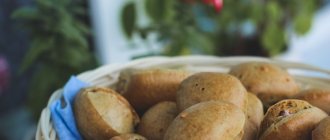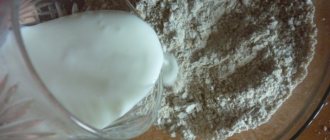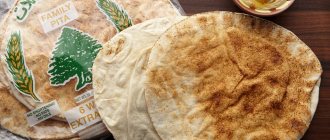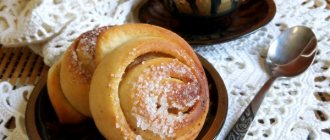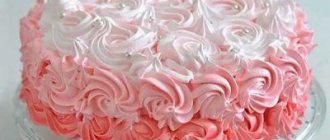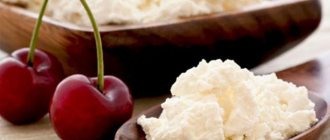Dietary properties:
How many calories are in custard, what dietary properties it has, all this is of great interest to those who lead a healthy lifestyle and monitor their health and figure. So we will try to answer these questions in the next article.
So here it is:
One of the most popular pastry creams is custard. You don't need any special skills to cook it. It is simply ideal for soaking cake layers, as a filling for cakes, eclairs and straws. Its distinctive feature is that it is cooked over fire, hence the name.
This delicacy always contains the following constant ingredients: granulated sugar, chicken eggs and cream. Note that the amount of sugar added to it, as well as the fat content of the cream, is determined by the taste of the confectioner, as well as by the type of confectionery product being prepared. For example, a thick and rich cream made from heavy cream is suitable for custard cakes.
In the preparation of curd desserts, a lighter type of custard is used.
Video
It is difficult to imagine a pastry or cake without pastry cream, at least in a minimal amount. This component of almost any culinary sweet dessert, including cocktails, has long gained great popularity in almost all countries of the world. Delicate, airy, with many flavor variations, becoming the basis or highlight of the dish, its range is high, although the composition is largely based on three components: sugar, butter and cream. Considering the fact that all of them are not able to boast of low calorie content and harmlessness to the figure, the finished cream also automatically goes into the category of those products that are not recommended for consumption during the process of losing weight, and simply in large quantities to avoid weight gain and in especially heavy cases of diabetes. And in order to make it easier to understand how many baskets of tea you can eat, you will have to study in detail the composition and calorie content of the cream, and subsequently determine its safest type.
How many calories are in custard?
Here's how much:
The calorie content of custard, per 100 grams, is:
Proteins, fats and carbohydrates (BJU) in gr. per 100 grams:
Proteins - 4.5
Fats – 3.6
Carbohydrates – 27.3
If you prepare it according to this recipe:
Products:
- Milk 2.5% - 500 g - (260 kcal)
- Eggs - 4 pcs. — (314 kcal)
- Sugar - 200 g - (748 kcal)
- Flour - 40 g - (137 kcal)
- Vanilla sugar - 5 g - (14 kcal)
How to cook:
- Mix eggs with sugar, then with flour, vanilla powder (or vanilla sugar), dilute with cold milk, mix until smooth.
- Place on medium heat and, stirring continuously, bring to a boil.
- If the cream is needed thicker, boil it for 5-10 minutes, stirring continuously, until thickened. Cool to a temperature of 40-50 degrees.
Glycemic index (GI) of custard:
So this product is classified as a medium glycemic index product.
Great video with a great recipe. Worth a look!
And further:
People suffering from diabetes mellitus, atherosclerosis, diseases of the liver and stomach, biliary tract and pancreas should treat this delicacy with caution. Those who want to get rid of extra pounds should also not get carried away with custard and other confectionery creams.
Curd cream - its use and properties
Curd cream is most often used to make desserts. Its delicate texture and pleasant curd flavor help highlight the taste of the dish and give it lightness. For curd cream, various additives are most often used, for example, raisins and nuts. The calorie content of curd cream depends on the presence of these additives in it, and the more of them, the more caloric the dish turns out to be.
A large amount of protein, phosphorus and calcium in cottage cheese has a beneficial effect on the human skeletal system, so curd cream will be useful for fractures, osteoporosis, children and pregnant women. For this cream, it is best to use homemade cottage cheese, which contains many essential amino acids and beneficial lactic acid bacteria.
Curd cream has practically no contraindications, except for the high calorie content of the cream. Therefore, it is approved for use both in old age and in children over 5 years old. It is rich in vitamins and microelements, but contains a lot of sugar, so if you have diabetes, diseases of the stomach, liver and pancreas, its use is also unacceptable.
Protein cream
Delicate, light and airy protein cream is loved by many adults and children. Pastries, tubes, cakes and other desserts with protein cream can decorate any holiday table and make the celebration more vibrant.
Preparing protein cream is simple and accessible for every novice cook. The basis of this cream is egg white, which is whipped until foamy along with sugar. Protein cream is used for straws, decorating cakes and pies. Its airy consistency is great for covering surfaces. But protein cream is not used as a layer. In addition, various products can be added to the protein cream, making it thicker or more flavorful. In this article we will tell you how to make protein cream at home.
Custard protein cream
This recipe is the most popular and in demand among housewives. To prepare custard protein cream you need: 2 egg whites, 2 tablespoons of powdered sugar, 25 ml of water, citric acid.
Pour granulated sugar into a saucepan, add water and place on low heat until thickened. Beat the whites with a broom or mixer until foamy in a separate bowl. Pour hot syrup into the resulting mass in a thin stream, continuing to whisk. You need to add citric acid to the resulting protein cream. You can use custard protein cream for eclairs and straws immediately after preparation.
Sugar syrup plays an important role in the protein custard recipe. If you don’t finish cooking it and pour it into the egg whites, the cream will turn out liquid and heavy. If the syrup is kept on the fire for too long and allowed to thicken too much, then after adding it to the proteins, lumps will form in the cream.
Protein-butter cream
To prepare the cream you will need: 2 egg whites, 100 grams of butter, 150 grams of sugar, 2 tablespoons of liqueur.
The butter should be melted until soft and thoroughly whipped to the consistency of thick sour cream. The whites should be mixed with sugar and also beaten with a mixer or broom until they become fluffy. Next, place the pan with the whites in a steam bath and continue beating for 2-3 minutes. After this, the contents of the pan should be cooled to a slightly warm state. Add butter to the whites and sugar in small portions, whisking and stirring constantly. You need to pour liquor into the resulting mass. The protein-butter cream should be cooled and can be used to prepare desserts. This protein cream recipe is great for cake.
Creamy protein cream
To prepare buttery protein cream you need: 4 egg whites, 1/2 cup sugar, 1 cup fresh cream. Beat the egg whites together with sugar until a foamy cream is obtained and add cream to them in small portions. The resulting mixture must be stirred and beaten very well. You can use creamy protein cream for eclairs, tubes and shortbread cakes.
Protein cream can be supplemented with a wide variety of additives. Various syrups add flavor to the cream, finely chopped fruits make the cream thicker and denser. If you prepare protein cream with gelatin, you can get marshmallows or a dessert similar to the filling of Bird's Milk candies. Gelatin should be added to sugar and water while preparing the syrup.
The calorie content of protein cream is low. However, a whole cake or a piece of cake with protein cream has a high calorie content, so when consuming them you should know when to stop.
Knowing how to prepare protein cream, you can delight your family and friends with delicious and fresh homemade sweets.
Dependence of the calorie content of the cream on its composition
Despite the fact that the recipe for confectionery cream is based on the “three pillars” - sugar, cream and butter - there can be more than a dozen additional ingredients to them, just as the methods of preparing this product will vary.
Therefore, the calorie content of curd, protein, butter or custard cream will be slightly different. Custard with a calorie content of 212 kcal is mainly used to fill eclairs and straws. For the cuisines of many countries, it is the base cream on the basis of which all other types of pastry creams are made. It consists primarily of sugar, eggs and heavy cream, to which ground nuts, vanilla and rum may be added, transforming the custard into frangipane, a French nut cream essential to pear pie. Or gelatin is poured in, to which cocoa or fruit juice is optionally added, resulting in the Bavarian cream necessary for cheesecakes. Despite the fact that custard is lighter in calories than all the others except cottage cheese, it is very difficult to call it dietary: 56% of the energy value belongs to fats, and it does not contain high-value components that would drown out the considerable calorie content of the custard. Of course, both butter and eggs, unlike sugar, have benefits for the body, but to obtain them a very small amount of these products is required, which cannot be said about their share in confectionery cream. Don’t delude yourself even about lemon custard with a calorie content of 178 kcal per hundred grams. Despite the fact that its “weight” is even less than that of the classic version, and it contains lemon juice, the concentration of this ingredient is not enough to protect the fat and calorie content of the cream, although the percentage of fat here is reduced to 52%. Therefore, the dietary properties of lemon, including its ability to speed up metabolism, unfortunately, will help little.
Butter or sour cream is one of the easiest to prepare at home. They often coat cakes at Medovik with it, or fill baskets, and add it to fruit salads, pancakes, and pancakes. In terms of calorie content, butter cream is not too different from sour cream: everything will depend on the percentage of fat content of the liquid mass added to the sugar. If cream is used, the calorie content of the cream is often slightly higher than that where sour cream is used. But the average figure is considered to be 226 kcal per hundred grams. The percentage of fat in the energy value is naturally also able to float from 57% to 60%. Such a slight difference is explained by the fact that for the production of butter cream, cream of 33% fat content is taken, since only this gives the necessary airiness. And for whipping sour cream - sour cream 25% fat for the same reason. Due to its composition, even with a relatively high calorie content, a cream based on sour cream or cream with sugar can be considered a rather valuable product, since it has most of the positive features inherent in sour cream or cream. This applies to protein, calcium, animal fats and vitamin A. On the basis of buttercream, adding butter and dark chocolate, a ganache cream is created, which is used as a glaze for confectionery products. The calorie content of such a cream exceeds all acceptable standards, producing 542 kcal per hundred grams, which is reduced only by the removal of butter from its composition, whose presence is not mandatory.
Protein cream in terms of calorie content is not too far from cream, since this indicator shows a value of 218 kcal per hundred grams, where up to 71% goes to carbohydrates. This is due to the composition of the cream, which usually contains only chilled egg whites, citric acid and powdered sugar. This cream hardens quite quickly, and therefore is used for decorating cakes and pastries, or filling baskets and tubes, familiar to many from Soviet culinary traditions. The caloric content of protein cream increases if butter is added to it, as a result of which the proportion of fats jumps and the beneficial component decreases, increasing the load on the liver.
The relationship between the calorie content of the cream and the components included in its composition
Despite the fact that in the process of preparing almost any cream, three main components are used (sugar, cream, butter), in addition to them, others can be added, of which there are more than a dozen.
That is why the calorie content of protein cream, curd, butter, custard and the calorie content of creme brulee differ significantly from each other.
Creme brulee has the highest calorie content; per 100 grams it is about 300 kilocalories. At the same time, a small amount of protein included in this cream prevents the process of building muscle mass. This is why experts do not recommend including creme brulee in a weight loss diet.
It is recommended to use this confectionery cream if there is a lack of animal fats, proteins, vitamins, carbohydrates in the body and with low nutrition.
Due to its high calorie content, creme brulee is contraindicated for diabetes mellitus, as well as diseases of the liver, stomach, pancreas and biliary tract.
Custard, which has about 212 calories, is most often used to fill eclairs or straws. In many countries, this cream is the base cream and other types of confectionery creams are made on its basis. The composition of the custard includes such components as chicken eggs, sugar and heavy cream; in addition, vanilla, rum and ground nuts can be added.
Despite the fact that custard has a lower calorie content than many others, it is very difficult to call it dietary, since 56% of its energy value comes from fats.
Of course, many components of this cream bring benefits to the body, but a very small amount is enough, which cannot be said about the proportions in which they are included in the custard.
Lemon custard, which has about 178 calories, is a little safer for your figure. But despite the fact that it contains lemon juice, its amount is not enough to completely protect the fat and calorie content of the cream.
The calorie content of protein cream is not much higher than that of custard, it is about 218 kilocalories, of which 71% comes from carbohydrates. This can be explained by the composition of the cream, which includes egg whites (chilled), citric acid and powdered sugar.
If butter is added, the calorie content of the protein cream increases significantly, thereby increasing the proportion of fats, and accordingly the load on the liver.
The least harmful in composition and calorie content is curd cream; its energy value is about 167 kilocalories. To prepare this cream, cottage cheese, cream and sugar are used.
Unlike other types of confectionery creams, the low calorie content of curd cream is combined with an insignificant percentage of fat content (up to 23%), which in turn, undoubtedly, depends on these indicators in the cream and cottage cheese used for its preparation.
The benefit of this cream is that it completely preserves all the valuable properties of cottage cheese, which in turn has a beneficial effect on muscle mass, teeth, bones, digestion and metabolic processes.
Curd cream, which is quite low in calories, can be used in their diet by those who carefully monitor their weight. At the same time, despite the fact that this dessert is not too harmful to the body, for dietary reasons it should be consumed in the first half of the day.
